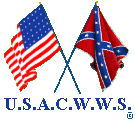
|
U. S. CIVIL WAR
PHOTOGRAPHS
|

|
LOOKOUT MOUNTAIN
PAGE 1 OF 5 PAGES
 127 127
View from the top of LOOKOUT MOUNTAIN, Tenn.
February 1864

In the text, the icon  is a link to the definition of the word it marks. is a link to the definition of the word it marks.
Use your browser's "back" button to return to the page.
 View of Chattanooga (background) and the Tennessee River
View of Chattanooga (background) and the Tennessee River
(foreground) taken from Lookout Mountain - 2002.
 127
127
View of Chattanooga (background) and the Tennessee River
(foreground) taken from Lookout Mountain - 1864.
(A part of the panoramic photograph at the top of this page.)
| |
November 23-25, 1863
Estimated Casualties : 12,485
total (US 5,815; CS 6,670) : 12,485
total (US 5,815; CS 6,670)
From the last days of September through October 1863, Gen. Braxton Bragg's army
laid siege to the Union
army under Maj. Gen. William Rosecrans at Chattanooga, cutting off its supplies.
On October 17, Maj. Gen. Ulysses S. Grant received command of the Western armies;
he moved to reinforce Chattanooga and replaced Rosecrans with Maj. Gen. George
Thomas. A new supply line was soon established. Maj. Gen. William T. Sherman
arrived with his four divisions to the Union
army under Maj. Gen. William Rosecrans at Chattanooga, cutting off its supplies.
On October 17, Maj. Gen. Ulysses S. Grant received command of the Western armies;
he moved to reinforce Chattanooga and replaced Rosecrans with Maj. Gen. George
Thomas. A new supply line was soon established. Maj. Gen. William T. Sherman
arrived with his four divisions in mid-November, and the Federals began
offensive operations. in mid-November, and the Federals began
offensive operations.
Battle of Chattanooga--Gen. Thomas's charge near Orchard Knob,
Nov. 24' 1863[--parts A.O.T. Potomac, Tenne. & Cumbd. engaged]
Kurz & Allison, Art Publishers, [c1888]. Lithograph, hand colored.
On November 24, 1863, Maj. Gen. Ulysses S. Grant, the Union commander, ordered
Maj. Gen. Joseph Hooker's force to storm Lookout Mountain. Hooker's men swept up
the western slope of the mountain and then charged around the base of the cliffs.
The battle reached its high point near the Craven House just below the cliffs.
The outnumbered Confederates were repeatedly pushed back.
Battle of Lookout Mountain--November 24' 1863.
4' & 14' Corps, Army of the Cumberland & Geary's Div.
o. 12' Corps, & 11' & 15' Corps A.O.T. Tenn. engaged.
Kurz & Allison, Art Publishers, [1889]. Lithograph, hand colored.
Because fog enveloped the mountain most of the day, soldiers nicknamed the battle
of Lookout Mountain the "Battle above the clouds".
On November 25, Union soldiers assaulted and carried the seemingly impregnable
Confederate position on Missionary Ridge. One of the Confederacy's two major
armies was routed. The Federals held Chattanooga, the “Gateway to the Lower
South,” which became the supply and logistics base for Sherman's 1864 Atlanta
Campaign1.
(Text Source: U.S. Gov't, National Park Service)
- In my opinion, Sherman's treatment of civilians during the upcoming Atlanta
Campaign was forecast by the following telegram from Chattanooga to President
Lincoln -Ed.:
 176
176
William T. Sherman to Abraham Lincoln, May 5, 1864
(First Page of a Telegram concerning General Orders No. 8).
From William T. Sherman to Abraham Lincoln1, May 5, 1864
[Note 1 Sherman's General Orders No. 8, issued on April 19, 1864,
stipulated that provisions would no longer be distributed to civilians at
military posts located south of Nashville. The orders also prohibited the sale
of provisions to civilians who were not employed by the government. Loyal
Unionists in East Tennessee petitioned Lincoln that this order was too harsh
and would cause many to starve. After receiving this petition Lincoln
telegraphed Sherman on May 5 and asked the general if something could be done
to help alleviate the suffering of the citizens in East Tennessee. See East
Tennessee Citizens to Lincoln, April 23, 1864 and Collected Works, VII, 330.
]
The following Telegram received at Washington, 1115 A M. May 5 1864.
From Chattanooga
Dated, May 5 1864.
We have worked hard with the best talent of the Country & it is demonstrated
that the railroad cannot supply the army & the people too, one or the other
must quit & the Army don't intend to unless Joe Johnston makes us. The issues
to citizens have been enormous & the same weight of corn or oats would have
saved thousands of the mules whose carcasses now corduroy the roads and which
we need so much. We have paid back to East Tenn. ten for one of provisions
taken in war. I will not change my order and I beg of you to be satisfied that
the clamor is partly a humbug & for effect, & to test it I advise you to tell
the bearers of the appeal to hurry to Kentucky & make up a caravan of cattle &
wagons & to come over by Cumberland Gap and Somerset to relieve their
suffering friends We on foot as they used to do before a
railroad was built Tell them they have no time to lose, We can relieve all
actual suffering by each company or regiment giving of their Savings, every
man who is willing to fight and work gets all ration, & all who won't fight or
work should go away and we offer them free transportation.
W. T. Sherman
Maj. Gen.
William T. Sherman to Abraham Lincoln, May 5, 1864 (Telegram concerning
General Orders No. 8). Transcribed and annotated by the Lincoln Studies
Center, Knox College, Galesburg, Illinois. Available at Abraham Lincoln
Papers at the Library of Congress, Manuscript Division (Washington, D.C.:
American Memory Project, [2000-02]),
http:/memory.loc.gov/ammem/alhtml/alhome.shtml, accessed [March 30, 2003].
|
|
|
PAGE TWO
 >
Civil War Photos
>
Western Battlefields
> Lookout Mountain
>
Page 2
>
3
>
4
>
5
>
Civil War Photos
>
Western Battlefields
> Lookout Mountain
>
Page 2
>
3
>
4
>
5
Notes
|
|


 127
127

 127
127




 176
176